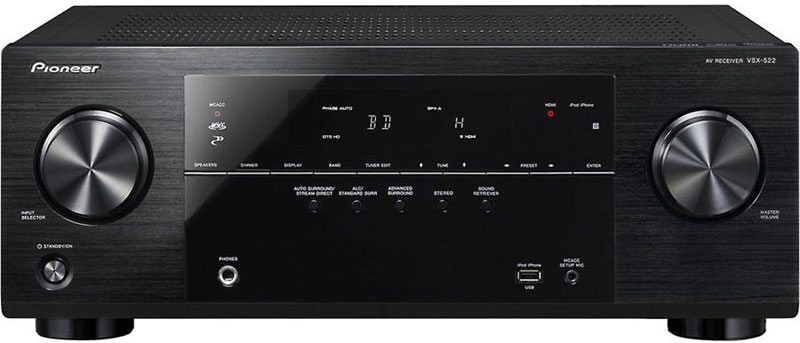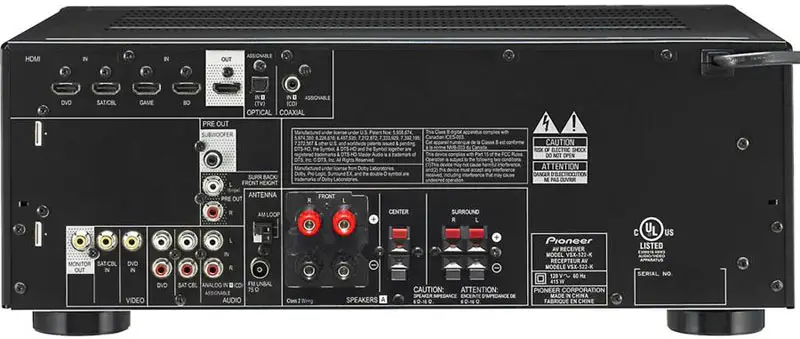Pioneer continues to be a strong leader in the audio equipment industry as the Japanese company continues to innovate in professional audio and DJ products. But when it comes to taking over the living room, Pioneer faces a lot of competition from companies that aim to bring their best home theater receiver products across many price points. Pioneer continues to be active in this area but they are also challenged to innovate and deliver exciting features and powerful specifications to their AV receivers. So far, Pioneer has yet to announce something new for 2013 but they still hold their ground with their 2012 family of Pioneer AV receivers. This family consists of 4 consumer models in the VSX series along with 2 high-priced SC models. 5 of the models are network ready except for the Pioneer VSX-522-K. Because of this, the VSX-522-K can appear a bit dated as many companies are trying to make the living room the center of a network-connected home. But those that don’t need that kind of connectivity may be attracted to the low price that the Pioneer VSX-522-K currently commands. The question is, what does the VSX-522-K have to offer on such a low price point?
Design
One important thing that the Pioneer VSX-522-K didn’t skimp on is the design. Compared to its predecessor, the VSX-520, the design is a step up as it uses a brushed aluminum faceplate and larger knobs. The control layout still looks minimal as this is an entry-level 5.1-channel home theater receiver but compared to the higher-end 2012 VSX models, the design looks strikingly similar. Physically, you are paying for quality so you can proudly display this home theater receiver and blend it with any other high-end home theater components that you may have.
Like other modern Pioneer home theater receivers, there are 2 knobs on the front which you can control for input selecting or volume adjusting. The buttons below the usual info display should speak for themselves and are quite similar in function to competing AV receivers. In short, if you used an AV receiver from a different manufacturer, you should have no problem operating the VSX-522-K through the front panel or included remote control.
The bottom portion of the front panel reveals something that the Pioneer VSX-520-K didn’t have and that is a USB port. This USB port is reserved for iPhone and iPod devices so people with these devices can amplify their music collection. Also found on the bottom portion is the usual setup mic and phones jacks.
The back side of the Pioneer VSX-522-K still remains simple but it has some worthy additions that were previously lacking in the VSX-520-K. There is an additional HDMI port bumping up the total to 4 HDMI inputs along with a single output. These HDMI ports sport the latest specification so 3D HDTV owners can plug and play. However, you won’t find any component video inputs and there is a reduced number of composite inputs. This can be seen as a good thing though because the back of the VSX-522-K looks far less intimidating.
Below is the back panel layout. Click on image to enlarge for a clearer view.
Features
The Pioneer VSX-522-K adapts the direct energy amplifier design and it has a slightly higher power output per channel than the VSX-520-K. With 400W of power, 5.1-channel surround sound configurations should function well with this home theater receiver. But the VSX-522-K isn’t just about raw power as there are some nice technologies baked into this low-cost home theater receiver as well.
With support for Dolby TrueHD and DTS-HD Master Audio, the Pioneer VSX-522-K is fully prepared in giving Blu-ray disc soundtracks the quality treatment. It also supports the Dolby Pro Logic IIz height channel for added audio quality. Any other entertainment sources that rely on Dolby and DTS formats should sound great thanks to this home theater receiver.
Of course, the results will vary depending on where you are sitting in the room. This highlights the importance of having a calibration system and Pioneer delivers with the Multi-Channel Acoustic Calibration system or MCACC. It works by plugging in the included microphone to the MCACC jack on the front of the home theater receiver. Once you start the calibration process, the microphone with gauge the distance between the microphone and the connected speakers. The size of the speaker is also taken into consideration along with the timbre and sound levels. The home theater receiver will use this data to make the appropriate calibrations to optimize the overall performance.
MCACC isn’t the only trick up Pioneer’s sleeve though. Pioneer also implemented a feature called Phase Control which uses a special phase matching technology to further boost the sound image at your desired listening position. Front Stage Surround Advance is another useful feature that creates a virtual surround sound environment out of the front speakers. This feature is useful if you are not into routing your speaker cables around the room to create a similar sounding setup.
Heavily compressed music files can also affect the overall audio performance. The VSX-522-K works around that problem by harnessing the Advanced Sound Retriever technology. This allows low bitrate MP3 files to sound close to CD quality. Considering the fact that people like to store low bitrate MP3s in their iPod and iPhone devices to accommodate more storage space, this feature takes away the sacrifice in audio quality. This feature can also enhance WMA and AAC file formats. However, switching the source from a portable audio device to something else like a TV can result to an annoyance in volume levels. Fortunately, Pioneer has another function called Auto Level Control that equalizes the volume automatically.
Bottom Line
The Pioneer VSX-522-K can be one of the best purchases ever if you fully understand and accept its limitations. There are no network connectivity options to speak of and Bluetooth is usually absent. If you will never upgrade to a 7.1-channel speaker system, the VSX-522-K is great and the technologies really push 5.1-channel systems to the limits. The $249 price tag makes this a tough little beast to beat.
Discontinued by Manufacturer


